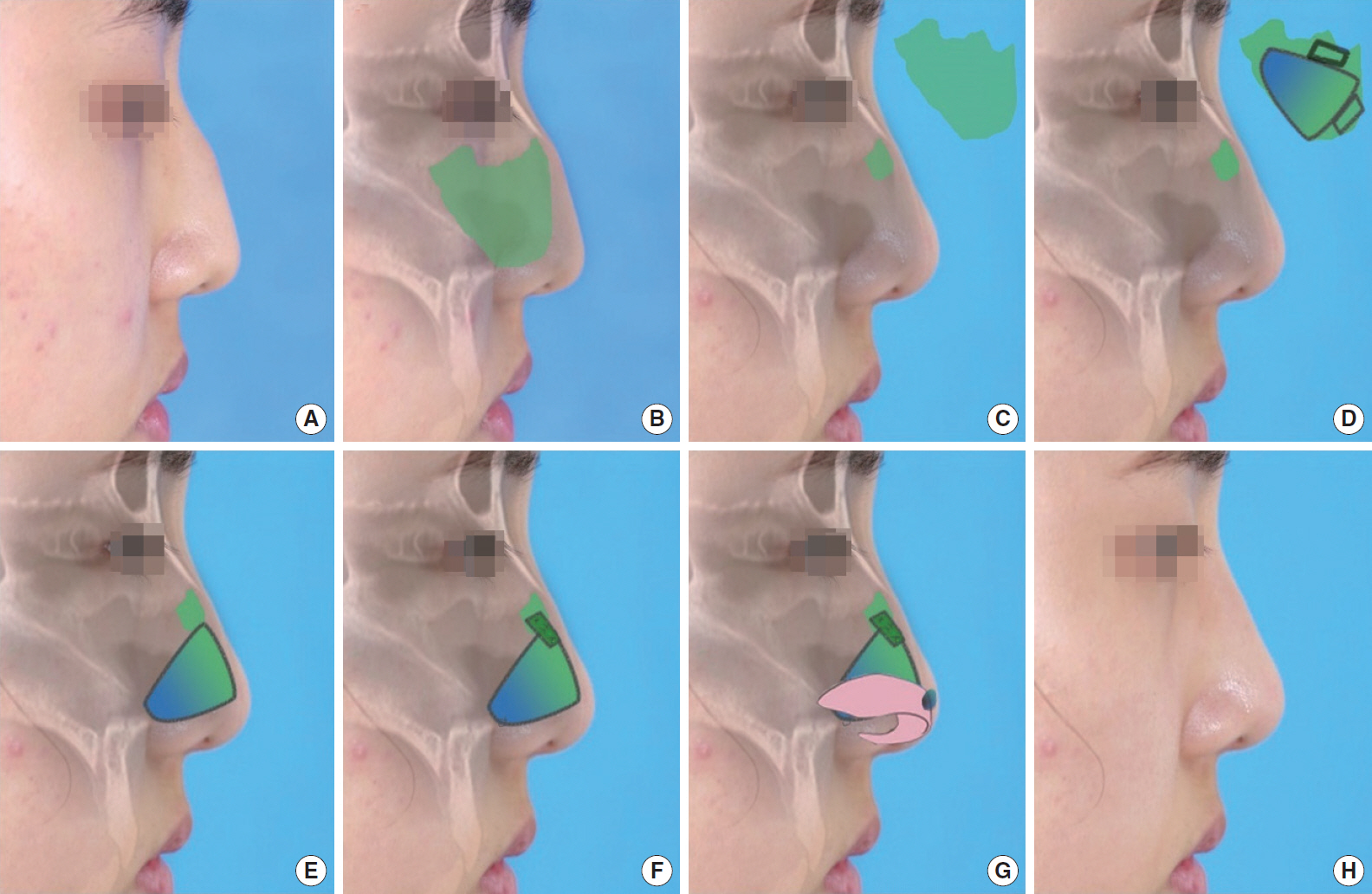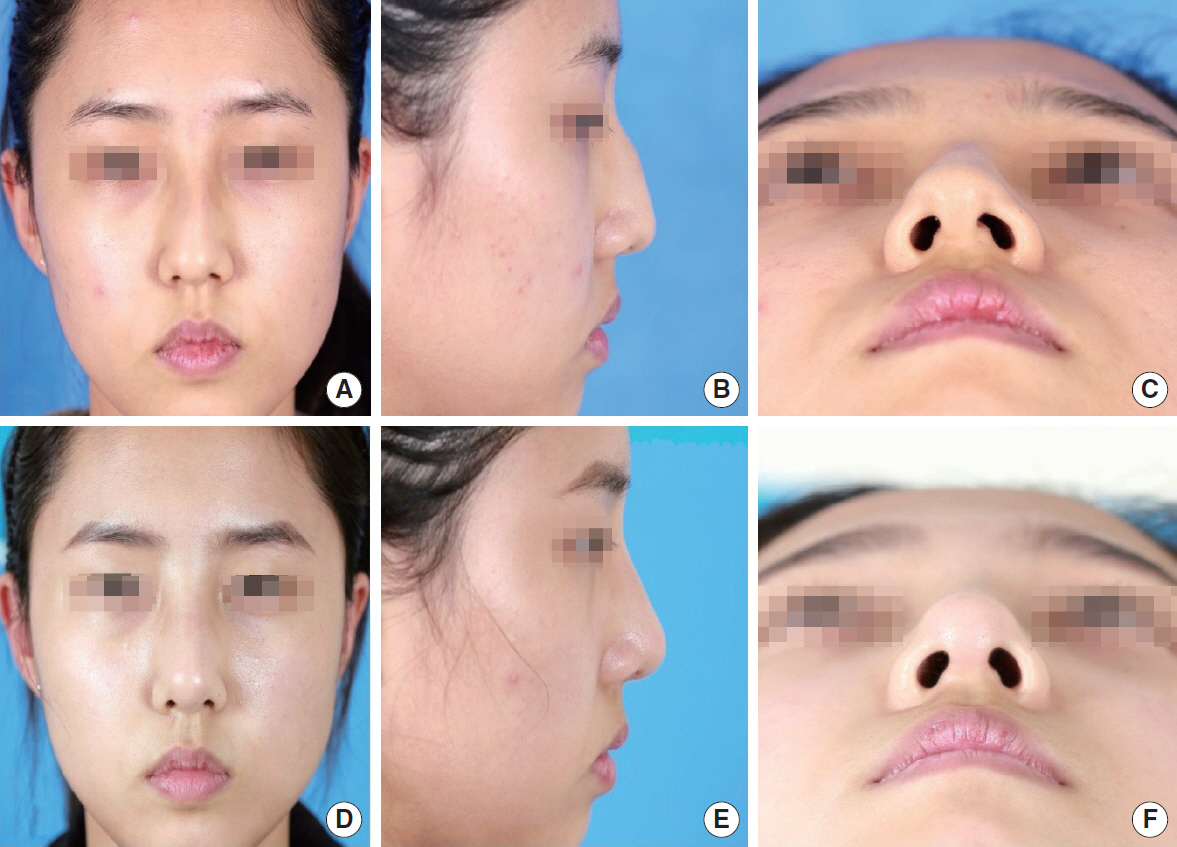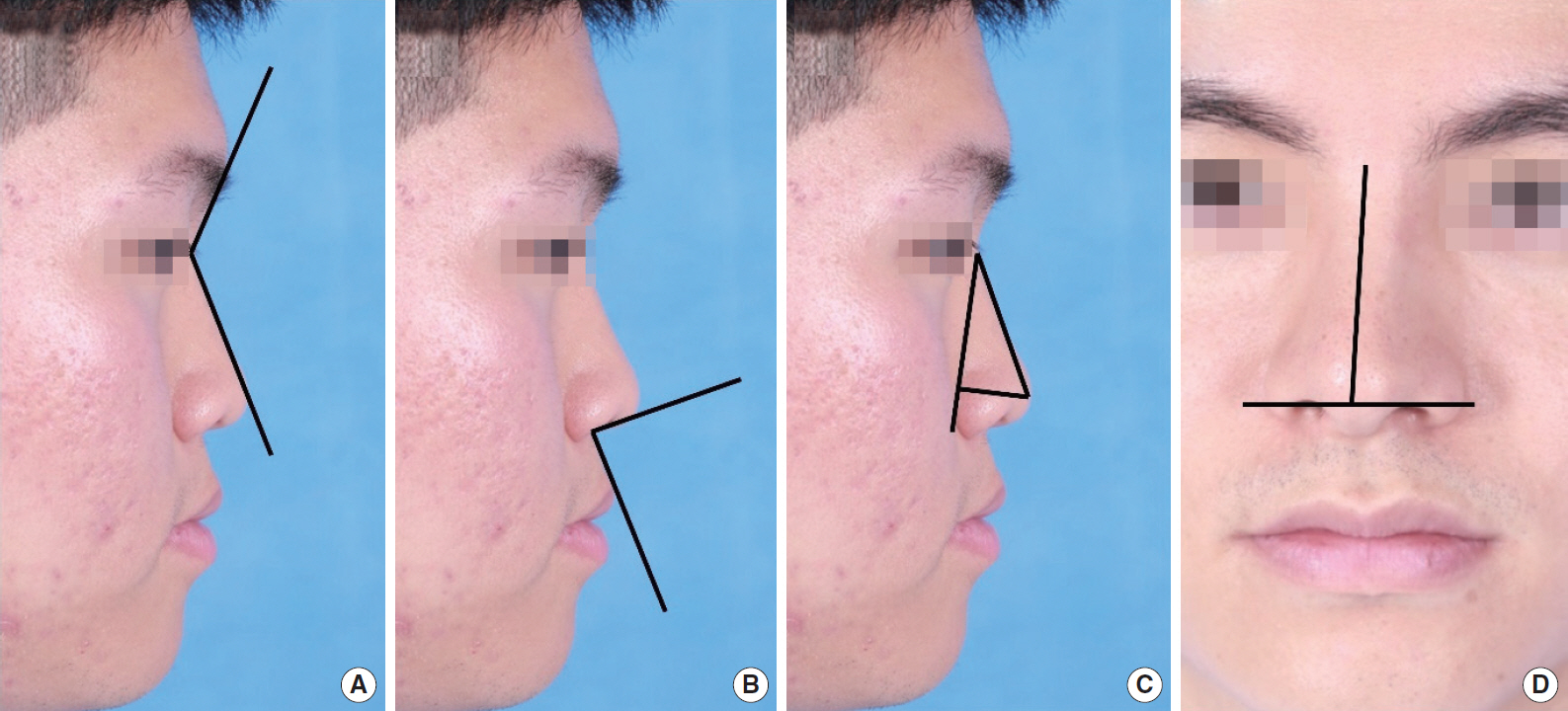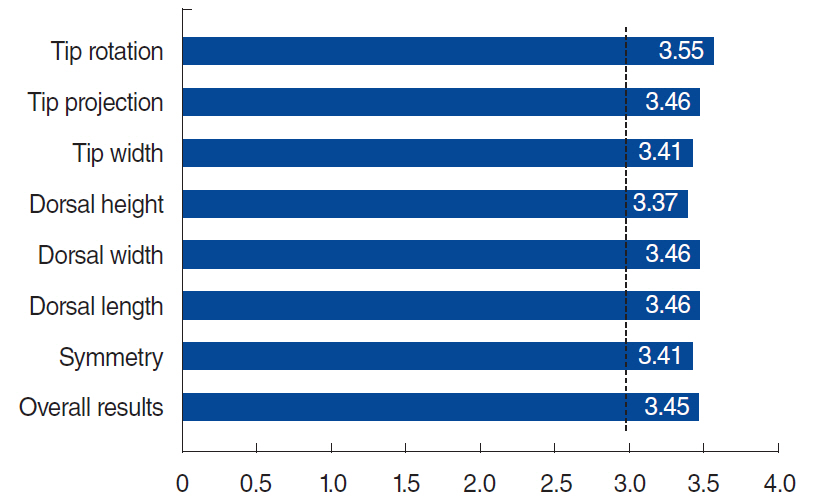Clin Exp Otorhinolaryngol.
2021 Feb;14(1):100-107. 10.21053/ceo.2019.01704.
Evaluation of the Esthetic and Functional Outcomes of Extracorporeal Septoplasty for Rhinoplasty in Asian Patients
- Affiliations
-
- 1Department of Otorhinolaryngology-Head and Neck Surgery, Pusan National University Yangsan Hospital, Yangsan, Korea
- 2Department of Otorhinolaryngology-Head and Neck Surgery, Chungbuk National University Hospital, Chungbuk National University College of Medicine, Cheongju, Korea
- KMID: 2512888
- DOI: http://doi.org/10.21053/ceo.2019.01704
Abstract
Objectives
. In extracorporeal septoplasty (ECS), the entire septal cartilage is harvested, and a neo-L strut is built extracorporeally. Thus, ECS can simultaneously achieve septum straightening and tip projection. This study evaluated the functional and esthetic outcomes of the ECS technique for rhinoplasty in Asian patients.
Methods
. We conducted a retrospective review of 64 patients who underwent rhinoplasty using ECS between January 2016 and March 2018. Subjective patient satisfaction was assessed and objective surgical outcomes were evaluated. Improvement in nasal obstruction was rated using a visual analog scale (VAS). Anthropometric changes were compared between preoperative and postoperative facial photographs. Complications and revisions were also analyzed.
Results
. The participants comprised 64 patients (48 males and 16 females, with a mean age of 29.3 years). The mean operative time was 89.3 minutes. In total, 61 patients were satisfied with the esthetic outcome, and the overall objective rhinoplasty outcome score was 3.45. Preoperative nasal obstruction symptoms (7.9±1.2 on VAS) improved postoperatively (3.1±1.3, P<0.001), and significant improvements were also observed in the nasofrontal angle (152.3° to 148.1°, P<0.001), nasolabial angle (88.8° to 92.0°, P<0.001), and nasal tip projection (0.62 to 0.66, P<0.033). Recurrent deviation of the nasal septum and external nose or tip deprojection did not occur in any patients, and there were no cases of revision during the mean follow-up period of 13.3 months.
Conclusion
. ECS might be an esthetically and functionally satisfactory alternative rhinoplasty technique for Asian patients with a shortage of septal cartilage.
Figure
Cited by 1 articles
-
Can We Kill Two Birds With One Stone? Achieving Function and Aesthetics by Extracorporeal Septoplasty
Yong Ju Jang
Clin Exp Otorhinolaryngol. 2021;14(1):9-10. doi: 10.21053/ceo.2020.02481.
Reference
-
1. Jang YJ, Alfanta EM. Rhinoplasty in the Asian nose. Facial Plast Surg Clin North Am. 2014; Aug. 22(3):357–77.
Article2. Jang YJ. Dorsal augmentation using costal cartilage: what is the best way? Clin Exp Otorhinolaryngol. 2019; Nov. 12(4):327–8.
Article3. Matory WE Jr, Falces E. Non-Caucasian rhinoplasty: a 16-year experience. Plast Reconstr Surg. 1986; Feb. 77(2):239–52.4. Aung SC, Foo CL, Lee ST. Three dimensional laser scan assessment of the Oriental nose with a new classification of Oriental nasal types. Br J Plast Surg. 2000; 53(2):109–16.
Article5. Wu WT. The Oriental nose: an anatomical basis for surgery. Ann Acad Med Singapore. 1992; Mar. 21(2):176–89.6. Zingaro EA, Falces E. Aesthetic anatomy of the non-Caucasian nose. Clin Plast Surg. 1987; Oct. 14(4):749–65.
Article7. Han SK, Lee DG, Kim JB, Kim WK. An anatomic study of nasal tip supporting structures. Ann Plast Surg. 2004; Feb. 52(2):134–9.
Article8. Choi JY, Kang IG, Javidnia H, Sykes JM. Complications of septal extension grafts in Asian patients. JAMA Facial Plast Surg. 2014; May-Jun. 16(3):169–75.
Article9. Jang YJ, Kwon M. Modified extracorporeal septoplasty technique in rhinoplasty for severely deviated noses. Ann Otol Rhinol Laryngol. 2010; May. 119(5):331–5.
Article10. Park P, Jin HR. Diced cartilage in fascia for major nasal dorsal augmentation in Asians: a review of 15 consecutive cases. Aesthetic Plast Surg. 2016; Dec. 40(6):832–9.
Article11. Choi JY, Park JH, Javidnia H, Sykes JM. Effect of various facial angles and measurements on the ideal position of the nasal tip in the Asian patient population. JAMA Facial Plast Surg. 2013; Nov-Dec. 15(6):417–21.
Article12. Wang JH, Jang YJ, Park SK, Lee BJ. Measurement of aesthetic proportions in the profile view of Koreans. Ann Plast Surg. 2009; Feb. 62(2):109–13.
Article13. Kim JS, Khan NA, Song HM, Jang YJ. Intraoperative measurements of harvestable septal cartilage in rhinoplasty. Ann Plast Surg. 2010; Dec. 65(6):519–23.
Article14. Byrd HS, Andochick S, Copit S, Walton KG. Septal extension grafts: a method of controlling tip projection shape. Plast Reconstr Surg. 1997; Sep. 100(4):999–1010.
Article15. Jin HR, Won TB. Nasal tip augmentation in Asians using autogenous cartilage. Otolaryngol Head Neck Surg. 2009; Apr. 140(4):526–30.
Article16. Ha RY, Byrd HS. Septal extension grafts revisited: 6-year experience in controlling nasal tip projection and shape. Plast Reconstr Surg. 2003; Dec. 112(7):1929–35.17. Kang JG, Ryu J. Nasal tip surgery using a modified septal extension graft by means of extended marginal incision. Plast Reconstr Surg. 2009; Jan. 123(1):343–52.
Article18. Emsen IM. A different approach to the reconstruction of the stubborn crooked nose with a different spreader graft: nasal bone grafts harvested from them removed nasal hump. Aesthetic Plast Surg. 2008; Mar. 32(2):266–73.19. Gunter JP, Rohrich RJ. Lengthening the aesthetically short nose. Plast Reconstr Surg. 1989; May. 83(5):793–800.
Article20. Lin J, Chen X, Wang X, Gao X, Zheng X, Chen X, et al. A modified septal extension graft for the Asian nasal tip. JAMA Facial Plast Surg. 2013; Sep-Oct. 15(5):362–8.
Article21. Lee SB, Jang YJ. Treatment outcomes of extracorporeal septoplasty compared with in situ septal correction in rhinoplasty. JAMA Facial Plast Surg. 2014; 16(5):328–34.
Article22. Won TB, Kang JG, Jin HR. Management of post-traumatic combined deviated and saddle nose deformity. Acta Otolaryngol. 2012; Jun. 132 Suppl 1:S44–51.
Article23. Jin HR, Kim DW, Jung HJ. Common sites, etiology, and solutions of persistent septal deviation in revision septoplasty. Clin Exp Otorhinolaryngol. 2018; Dec. 11(4):288–92.
Article24. Kantas I, Balatsouras DG, Papadakis CE, Marangos N, Korres SG, Danielides V. Aesthetic reconstruction of a crooked nose via extracorporeal septoplasty. J Otolaryngol Head Neck Surg. 2008; Apr. 37(2):154–9.
- Full Text Links
- Actions
-
Cited
- CITED
-
- Close
- Share
- Similar articles
-
- Rabbit model for the study of nasal tip plasty: a comparative cephalometric analysis after rhinoplasty
- Surgical anatomy for Asian rhinoplasty: Part III
- Open rhinoplasty in secondary cleft nose deformity with suture techniques
- Primary Septoplasty in the Treatment of Nasal Bone Fractures
- Nasal tip surgery: nasal lengthening and augmentation in Asian rhinoplasty







